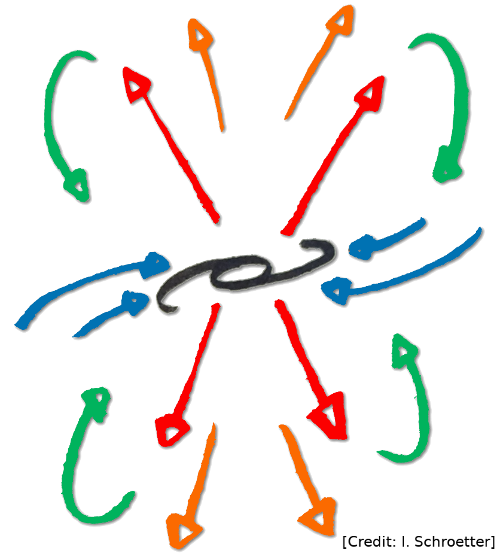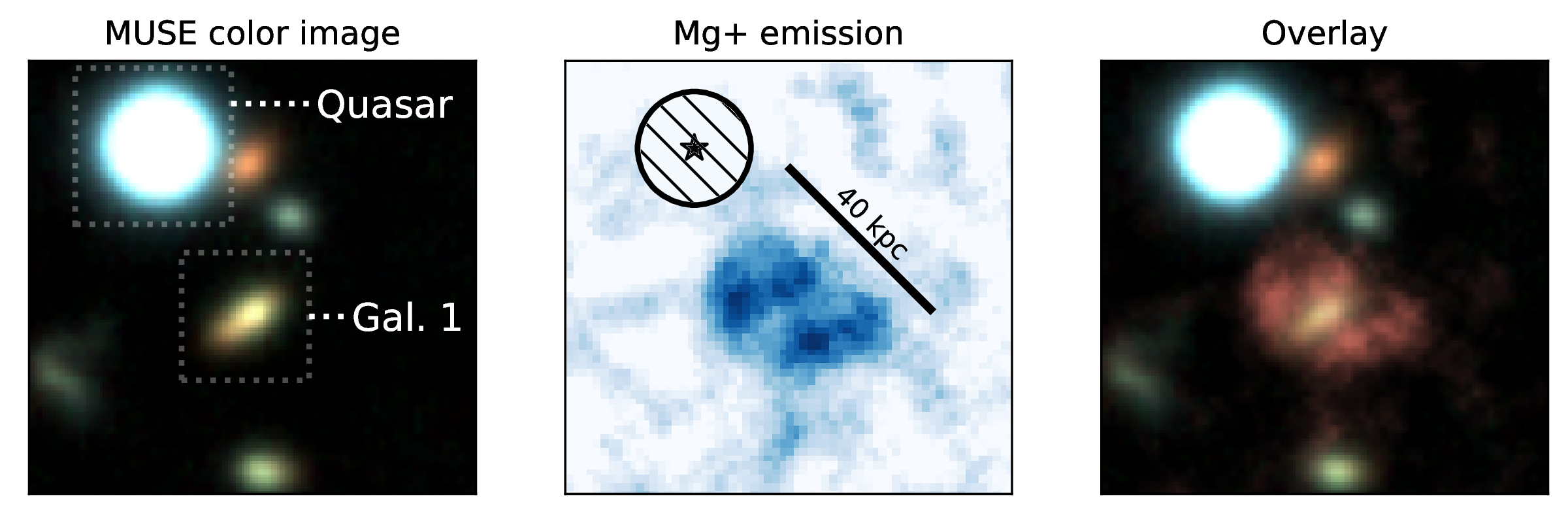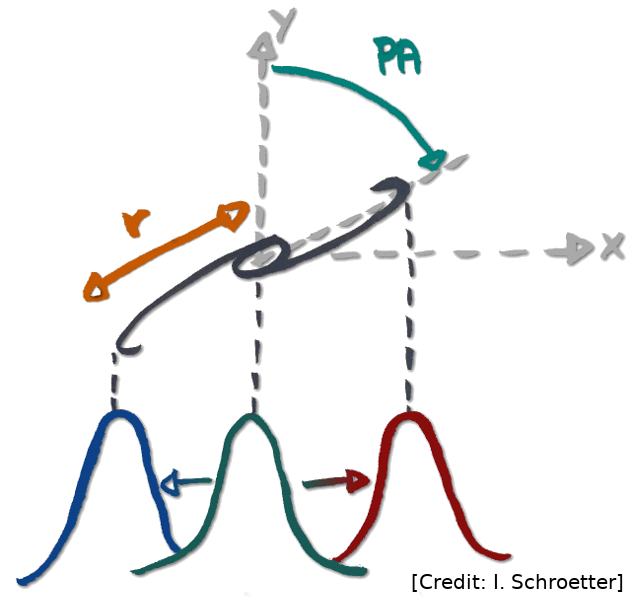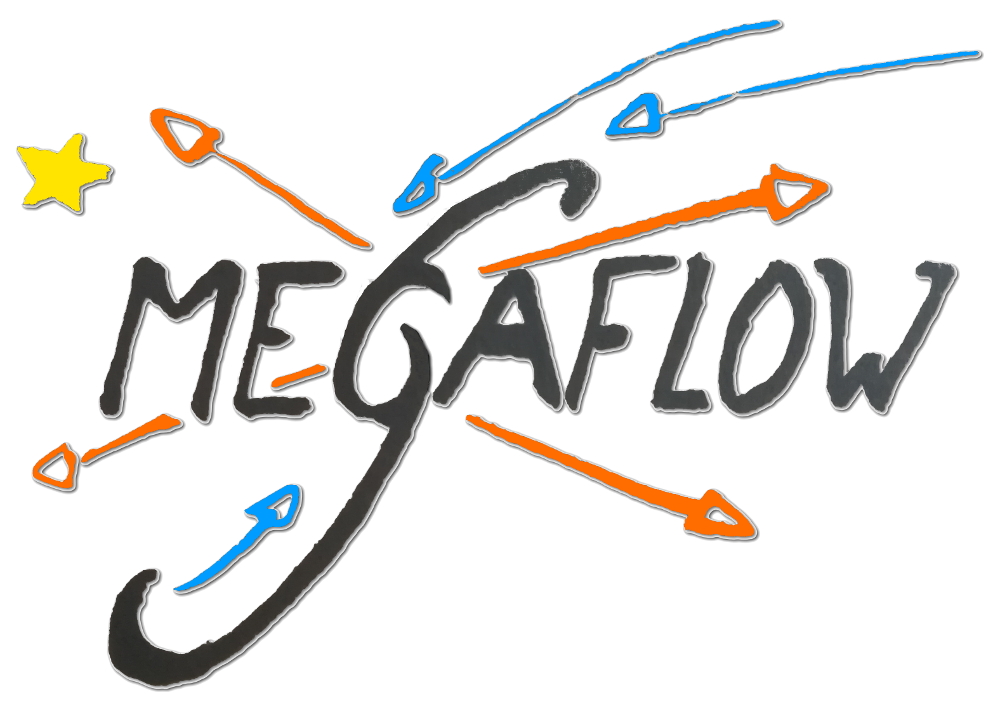Gas flows around galaxies: the baryon cycle

Introduction
In the era of precision cosmology, astronomers still need to understand how intergalactic gas flows into galaxy halos [inflows], and how supernovae eject gas, metals, and energy back into the intergalactic medium [outflows]. Regarding inflows, a variety of observations indirectly indicated that continuous replenishment of the gas reservoir of galaxies must occur, but direct evidence for accretion remains elusive. In contrast, evidence of outflows or galactic-winds is ubiquitous, but our knowledge of their physical origin and properties is still in its infancy after decades of research in this area.
These gas in- and out-flows processes play a critical role in regulating the growth of galaxies, but our limited knowledge on their properties prevents our ability to produce accurate numerical simulations. This project aims at putting direct constraints on both in- and out-flow processes through innovation around 2 fronts:
The MEGAFLOW survey
The Muse GAs FLow and Wind [MEGAFLOW] survey aims at observing a statistical number (80+) of galaxy-quasar pairs to allow analysis of the relation between the absorption and the host galaxy properties. From the Zhu and Ménard Mg II catalog based on SDSS (Zhu & Ménard 2013), we selected quasars with multiple (N≥3) Mg II λλ 2796,2802 absorption lines with redshifts between 0.4 and 1.4 and with a Mg II λ2796 rest-equivalent width (REW) Wλ2796 > ~0.5A. The former criteria of having multiple absorbers in one quasar field, ensures that a large number of galaxy-quasar pairs of 80+ is reachable with 20−25 quasar fields. The latter criteria ensures that the host galaxies are within 100 kpc from the quasar LOS (at z ≈ 1), i.e. within the MUSE field-of-view, given the well known anti-correlation between the impact parameter and Wλ2796r (Lanzetta & Bowen 1990; Steidel 1995).Overall, the MEGAFLOW survey is made of 22 quasar fields, with each quasar spectrum having at least 3 strong (Wλ2796r >0.5A) Mg ii absorbers, over the redshift range between 0.4 and 1.5. Including a few serendipitous systems with 0.3 < Wλ2796r < 0.5 A, the survey containts a total of 79 Mg ii absorbers with Wλ2796r >0.3 A
2025

2021

2016
2014:

Science
MEGAFLOW provides the following science cases:Published papers:

- Schroetter et al. 2016ApJ…833…39S Muse Gas Flow and Wind (MEGAFLOW). I. First MUSE Results on Background Quasars
- Zabl et al. 2019MNRAS.485.1961Z MusE GAs FLOw and Wind (MEGAFLOW) II. A study of gas accretion around z ≈ 1 star-forming galaxies with background quasars
- Schroetter et al. 2019, MNRAS.490.4368S MusE GAs FLOw and Wind (MEGAFLOW) III. galactic wind properties using background quasars
- Zabl et al. 2020, MNRAS, 492, 3 MusE GAs FLOw and Wind (MEGAFLOW) IV. A two sight-line tomography of a galactic wind
- Wendt et al. 2021, MNRAS, 502, 3733. MusE GAs FLOw and Wind (MEGAFLOW) V. The dust/metallicity-anisotropy of the circum-galactic medium
- Schroetter et al. 2021, MNRAS, 506, 1355. MusE GAs FLOw and Wind (MEGAFLOW) VI. The CIV/MgII covering fraction
- Freundlich et al. 2021, MNRAS, 501, 1900. MusE GAs FLOw and Wind (MEGAFLOW) VII. A NOEMA pilot program to probe molecular gas in galaxies with measured circum-galactic gas flows
- Zabl et al. 2021, MNRAS, 507, 4294. MusE GAs FLOw and Wind (MEGAFLOW) VIII. Discovery of a Mg+ emission nebula probed by a quasar sightline »
- Langan et al. 2023, MNRAS, 521, 546. MusE GAs FLOw and Wind (MEGAFLOW) IX. The impact of gas flows on the mass-metallicity relation
- Cherrey et al. 2024, MNRAS, 528, 481. MusE GAs FLOw and Wind (MEGAFLOW) X. The cool gas and covering fraction of Mg ii in galaxy groups
- Schroetter et al. 2024, A&A, 687, 13. MusE GAs FLOw and Wind (MEGAFLOW) XI. Scaling relations between outflows and host galaxy properties
- Bouché et al. 2025, A&A. 694, 67 The MusE GAs FLOw and Wind (MEGAFLOW) XII. Rationale and design of a MgII survey of the cool circum-galactic medium with MUSE and UVES
- Cherrey et al. 2025, A&A, 694, 117 MusE GAs FLOw and Wind (MEGAFLOW) XIII. Cool gas around isolated galaxies traced by \MgII\ absorptions
- DeFellipis, Bouché, Genel et al. 2021, ApJ, 923, 56 « A Comparison of Circumgalactic Mg II Absorption between the TNG50 Simulation and the MEGAFLOW Survey »
- DeFellipis, Bournaud, Bouché, et al. 2024, MNRAS, 530, 52 « The Effect of Cosmic Rays on the Observational Properties of the CGM »
MEGAFLOW and Simulations
In preparation papers
- Wendt et al. (in prep.) A&A MusE GAs FLOw and Wind (MEGAFLOW) XIV. The cool neutral haloes of galaxies.
- Guo et al. (in prep.) A&A MusE GAs FLOw and Wind (MEGAFLOW) XXX. The size of the cool clouds in the CGM
- Bouché et al. (in prep.) A&A MusE GAs FLOw and Wind (MEGAFLOW) XXX. The scaling relations of the cool CGM
- Bouché et al. (in prep.), A&A MusE GAs FLOw and Wind (MEGAFLOW) XXX. Are the dark matter and gaseous halos of galaxies linked?


